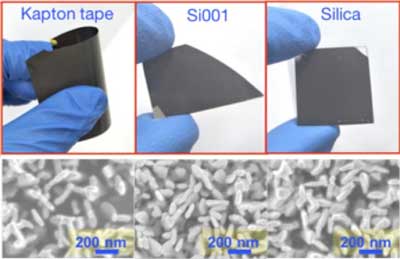| Dec 03, 2018 | |
Inexpensive new nanomaterial has applications ranging from biomolecule detectors to solar energy conversion(Nanowerk News) Researchers from the Singapore University of Design and Technology (SUTD) have engineered a new inexpensive nanomaterial that has applications ranging from biomolecule detectors to solar energy conversion. |
|
| The key to the material's remarkable performance is its nanostructure, which strongly interacts with visible and infrared light. This nanomaterial is easily coated onto other materials, including plastics, thus providing them with new functions. | |
 |
|
| Highly absorbing (black) self organized Ag nanostructure form on flexible plastics as well as glass and silicon. (Image: SUTD) | |
| The nanomaterial can be used to improve solar cells as it is strongly absorbs light, and in addition its structure can be engineered to optically detect minute traces of biomolecules. The material consists of silver particles, which are 1000 times smaller than the width of a human hair. | |
| Unlike other methods used nanostructures, the fabrication method for this nanomaterial does not require acids and is performed at room temperature. This means that the material can be coated onto a range of substrates, including flexible plastics. | |
| SUTD's Assistant Professor Robert Simpson said "The material can be deposited at room temperature on a range of substrates without patterning or acids. So far we have deposited the material over 100 mm diameter plastic, Si and Silica samples. This single step large area fabrication method makes the material industrially relevant. Indeed, the nanostructures were grown using a modified technique that is commonly used to manufacture tinted films on large area window glass." | |
| The solar absorption measurements were published in Nano Energy ("Flexible omnidirectional and polarisation-insensitive broadband plasmon-enhanced absorber"), in collaboration with Dalian University of Science and Technology, whilst the biomolecule measurements were published in ACS Applied Materials & Interfaces ("Large-Area Silver–Stibnite Nanoporous Plasmonic Films for Label-Free Biosensing"). |
| Source: Singapore University of Technology and Design | |
|
Subscribe to a free copy of one of our daily Nanowerk Newsletter Email Digests with a compilation of all of the day's news. |
